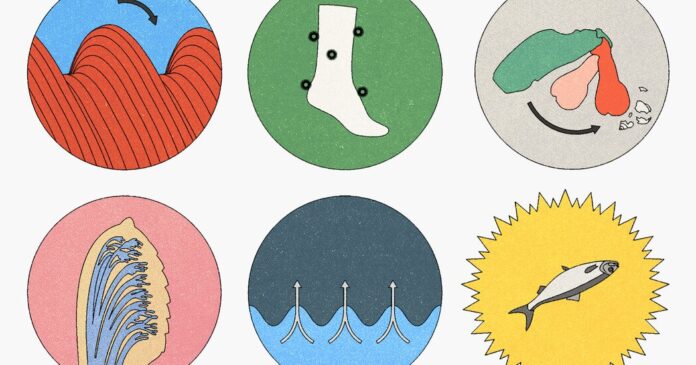From Velcro to bulletproof vests, engineers have long looked to nature’s blueprints for innovation. Today, sophisticated tools and increased collaboration are pushing this “bioinspiration” field into exciting new territory, yielding inventions like soft batteries and water-walking robots. However, government funding cuts threaten the progress made in this burgeoning area of research.
Cassandra Donatelli, a biologist at the University of Washington Tacoma, sees bioinspiration as experiencing a golden age. She highlights the crucial role that interdisciplinary collaboration plays. “We have a biomechanics lab here where we have six or seven engineers and 10 biologists. We’re all physically in the same building, together doing work,” she explains. This collaborative environment fosters the cross-pollination of ideas essential to translating biological principles into practical technologies.
The Trump administration’s proposed budget cuts for the National Science Foundation (NSF) pose a significant challenge to bioinspiration. While prioritizing fields like artificial intelligence and quantum computing, these cuts threaten to redirect funding away from research on soft batteries, self-healing materials, and other groundbreaking concepts inspired by nature. Duncan Irschick, a biologist at the University of Massachusetts, warns, “That work will suffer with N.S.F.’s new priorities. I sincerely worry about handing the mantle of bioinspired research to China.”
Despite these concerns, the successes already achieved through bioinspiration offer a glimpse into its transformative potential:
Nature’s Velcro
The burrs of the Burdock plant are masterfully equipped with tiny hooks that snag onto fur and clothing, effectively spreading seeds. Swiss engineer George de Mestral stumbled upon this ingenious design while on a hunting trip in 1941. His subsequent microscopic examination revealed the intricate hook-like structures and sparked an idea: what if these could be replicated to create a reusable fastener? After discovering nylon’s suitability for bending into permanent hooks, he patented his invention in 1955, christening it “Velcro,” a blend of the French words for “velvet” and “hooks.”
Beaks Designed for Speed
In the 1980s, Japanese engineers faced an unexpected challenge when developing their high-speed bullet trains. As these sleek machines hurtled through tunnels at speeds exceeding 220 miles per hour, they generated sonic booms due to compressed air buildup ahead of them. Eiji Nakatsu, a train engineer with a passion for birdwatching, sought inspiration from nature’s designs. He observed the kingfisher bird’s streamlined beak, which seamlessly enters the water without creating ripples.
Nakatsu incorporated this principle into his trains by rounding and tapering their front ends, mimicking the kingfisher’s profile. This design modification effectively reduced air pressure within tunnels by 30%, leading to quieter and more efficient operation of these high-speed marvels.
Whale Flow: Efficiency from Nature’s Knobs
Humpback whale fins possess distinctive knobs along their leading edge—tubercles—that play a critical role in their underwater prowess. These tubercles, discovered to be vital for creating smooth water flow over the fin and generating extra lift, became a point of fascination for Frank Fish, a biologist at West Chester University.
Fish and his team recognized the potential application of this design principle beyond marine biology and patented their discovery. Since then, tubercles have been incorporated into various fields: extending the lifespan of wind turbine blades, enhancing the efficiency of industrial ceiling fans, and even improving surfboard fin performance and truck mirror design.
Geckos, Glue-Free Adhesives
The gecko’s remarkable ability to cling effortlessly to smooth surfaces—glass walls included— stems from millions of tiny hairs on its toes. Each hair splits into hundreds of microscopic branches that create an incredibly strong Van der Waals force when pressed against a surface, allowing the gecko to stick without any adhesive.
Duncan Irschick and his colleagues at the University of Massachusetts painstakingly recreated this principle with their “Geckskin” fabric. This synthetic material boasts adhesion comparable to powerful glues but allows for clean detachment—a significant advantage in various applications like robotics, medical devices, and even climbing gear.
Pitcher Plants: Learning from Natural Slippery Surfaces
Pitcher plants lure unsuspecting insects into their slippery-rimmed traps with a deceptively tempting pool of digestive enzymes. When raindrops or dew collect on the rim, microscopic bumps and ridges pull the water into an adhesive film that ensnares visiting prey.
Joanna Aizenberg, an engineer at Harvard, investigated this mechanism and replicated it in materials engineering. These pitcher plant-inspired coatings resist dust buildup and offer superior cleaning properties. Imagine pipes free from clogging sticky fluids or ship hulls immune to barnacle infestations—all thanks to a little botany applied to material science.
Mantis Shrimp: The Punch Behind the Power
The mantis shrimp, armed with club-like appendages called dactyl clubs, boasts an incredible punch capable of cracking open shellfish with force equal to that of a .22 caliber bullet. What prevents these powerful strikes from pulverizing the shrimp’s own limbs?
The answer lies in a complex layered structure within the dactyl clubs resembling both herringbone patterns and corkscrew bundles. This intricate design effectively disperses the energy generated by each punch, safeguarding the club itself while delivering devastating blows. Researchers at the National Institute of Standards and Technology have successfully mimicked this shock-absorbing layering in an artificial material. When tested against high-velocity impacts, it absorbed the force without fracturing, potentially paving the way for lightweight shields to protect spacecraft from micrometeoroids.
Ripple Bugs: Tiny Bots that Walk on Water
Imagine tiny robots, only a grain of rice in size, effortlessly zipping across water surfaces at speeds up to 120 body lengths per second—equivalent to 400 miles per hour for humans! This extraordinary feat is achieved by ripple bugs, leveraging specialized fan-like hairs on their middle legs. As they dip these legs into the water, surface tension causes the stiff fronds to spread instantaneously, acting as oars.
Victor Ortega-Jiménez, a biologist at the University of California, Berkeley, and his team drew inspiration from this ingenious mechanism to create their own “Rhagabots”—tiny robots mimicking ripple bugs’ movement across water surfaces. These bots can navigate efficiently, change direction rapidly, and brake sharply, all while requiring minimal energy thanks to surface tension doing much of the work.
Electric Eels: Soft Batteries for Medical Implants
Electric eels generate powerful shocks through specialized tissues capable of producing high voltage. Researchers are now turning their attention to these unique biological batteries, seeking inspiration for safer power sources for implantable medical devices. The challenge lies in mimicking the eel’s ability to store and release electrical energy without harmful chemical byproducts found in conventional batteries.
While challenges remain—including finding suitable biocompatible materials and scaling up production—the potential of soft batteries based on electric eel physiology holds enormous promise for revolutionizing medical technology, enabling longer-lasting and safer power sources for pacemakers, insulin pumps, and other life-sustaining implants.
Bioinspiration continues to evolve, offering a powerful testament to the ingenuity inherent in both natural selection and human innovation. The future promises even more surprising breakthroughs as we delve deeper into nature’s inexhaustible wellspring of design solutions.

































